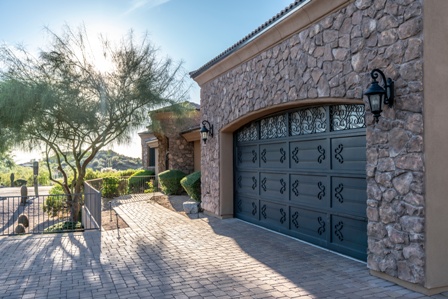When planning a home improvement project, your garage door might not be the first thing that comes to mind. However, it is crucial to your home’s aesthetic and functionality.
Selecting the ideal material for your custom garage door is vital. This choice affects its lifespan, maintenance requirements, and, undoubtedly, its visual appeal. Here’s how to make this essential decision:
1. Consider Your Home’s Style
Before opting for any custom garage door installation, the style of your home is a reflection of its character and charm, acting as a visual story of its design journey. This story should be coherent and fluid when choosing a garage door material.
For instance, a Victorian-style home might feel disjointed with a minimalist aluminum door. On the other hand, a modern house with a heavily ornate wooden door could look out of place.
The garage door’s material and design should seamlessly integrate, enhancing the overall architectural narrative of the home. Let your home’s distinct style guide your choice, assuring a harmonious and appealing look.
2. Evaluate Your Local Climate
The climate in which you reside can greatly influence the material choice for your garage door. Certain materials are better equipped to handle specific weather patterns and conditions.
So, to avoid garage door purchasing mistakes, it’s wise to familiarize yourself with your local climate. Doing so will help you ensure a longer lifespan for your garage door while minimizing maintenance hassles. Here’s a quick guide:
Humid Climates:
In consistently moist and humid locations, materials like wood that can warp or rot might not be the best choice. Instead, fiberglass or steel with a rust-resistant coating can provide durability without concerns about deterioration.
Cold Climates:
Those residing in regions with harsh winters should prioritize insulation. Insulated steel or composite materials are champions at resisting cold and retaining warmth, which can benefit both vehicles and any adjacent living spaces.
Hot And Sunny Climates:
Constant sun exposure can be harsh on some garage door materials, causing them to fade or degrade. Aluminum, with its UV-resistant properties, is a wise choice for such conditions, maintaining the door’s hue and strength.
Factoring in your local climate ensures your garage isn’t only aesthetically pleasing but also optimized for local weather conditions.
3. Think About Maintenance Needs
How much time are you willing to dedicate to garage door upkeep? Each material presents its own set of upkeep demands. Knowing these can help your door stay in peak condition for an extended period:
Wood:
While undeniably beautiful, wood demands regular maintenance. It may require repainting or resealing every couple of years to maintain its look and protect it from the elements. Moreover, wood can be susceptible to pests like termites, requiring periodic checks.
Steel:
More resilient than wood, steel may occasionally need repainting, especially if scratches or dents appear. However, with proper care, it can resist rust and wear for a long time.
Aluminum:
Known for being rust-resistant, aluminum doors are low-maintenance but can be prone to dents. A simple wash with soap and water can often restore its shine.
Fiberglass And Vinyl:
Both are low-upkeep choices. They’re resistant to rot and pests, but repairs can be tricky if damaged. Regular cleaning ensures they remain in pristine condition.
The longevity of your garage door often depends on consistent and proper care, regardless of the chosen material. Periodic inspections and upkeep can save costs in the long run and keep your door functioning smoothly.

4. Determine Your Budget
Before making a decision, it’s crucial to define your budget and acquaint yourself with potential garage door installation costs. Setting a budget helps narrow down choices and prevents you from being lured by premium products beyond your financial capacity. But remember that a higher price tag doesn’t always guarantee superior quality.
With thorough research and a keen eye, you can find materials that offer durability and aesthetic appeal without breaking the bank. By being financially savvy and prioritizing your needs, you can make an informed decision that aligns with both your vision and your wallet.
5. Play With Aesthetics
Selecting the optimal garage door material isn’t solely about durability and practicality—it’s also about making a style statement. The visual charm of your garage door can transform your home’s façade. Here’s what to consider:
Color Coordination:
The material should either be paintable or available in hues that harmonize with your home’s exterior. For instance, while wood can be stained or painted to your liking, aluminum doors offer a modern metallic sheen.
Texture And Finish:
Some materials offer unique textures and finishes. A grainy finish on wood exudes rustic charm, while a smooth, glossy finish on fiberglass can look ultra-contemporary.
With the suitable material and design, your garage door can become more than just a functional necessity—it can be a focal point of your home’s facade.
Conclusion
Selecting the best material for your custom garage door is a blend of practical considerations and personal taste. By evaluating your home’s style, local climate, maintenance preferences, budget, and aesthetics, you can find the perfect fit that not only enhances your home’s appearance but also serves you efficiently for many years. Remember, it’s more than just about picking a door —it’s about aligning with your home’s essence and your way of life.

